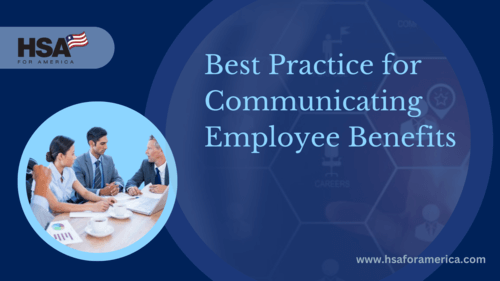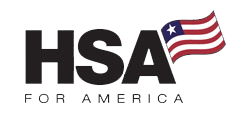As a small business owner, you know how important it is to attract and retain the best talent to help your organization grow. And employee benefits are a critical part of that process. Communicating those employee benefits is very important.

Communicating Employee Benefits
Workers are more willing to stay with a company they feel is taking good care of them.
Offering a comprehensive benefits package that includes options like Health Reimbursement Arrangements (HRAs) and Health Savings Accounts (HSAs) is a critical first step. But it’s equally important to communicate the value of these benefits effectively to your team.
And it’s not enough to just mention benefits during open enrollment periods.
Staying connected to your employees to help them feel appreciated is a year-round effort. But in today’s competitive job market, going the extra mile to make sure your employees feel valued and supported can make all the difference.
This article will provide you with valuable insights and strategies on how to communicate employee benefits effectively to help keep your staff happy, healthy, and connected.
Why Is Communicating Employee Benefits So Important?
Great employee benefits go beyond the workplace. They effectively support the overall wellbeing of your people, both inside and outside of work.
But just because you are providing excellent benefits to your employees doesn’t mean everyone is taking full advantage of them.
There are several reasons why employees may not utilize all the benefits provided by their employers:
- Lack of Awareness – They might not be aware of all the benefits available to them. If the communication about these benefits is not clear and frequent, employees may not fully understand what is offered.
- Complexity of Benefits – Sometimes, the details of benefits packages can be complex and difficult to understand. Employees might feel overwhelmed or confused by the options and avoid using them.
- Perceived Irrelevance- They may think certain benefits are irrelevant to their current situation or needs.
- Access and Convenience Issues – They may feel certain benefits are too complicated or inconvenient to access, and may decide it’s too much of a bother to use them.
- Lack of Personalization – Some of the benefits may not appeal to all of the employees. Finding a way to help personalize benefits to your current team will help them see the value in what is offered.
- Insufficient Communication – It’s not enough to just mention benefits briefly when an employee is first hired, and at annual reviews. You will want to explore ways to keep the excitement and value of all the offered benefits fresh in everyone’s mind on an ongoing basis.
- Cultural and Language Barriers – If you employ a culturally diverse workforce, there may be language and other cultural barriers that prevent a full understanding of what is being offered.
- Trust Issues – Sometimes employees have had bad experiences in other companies with benefits not meeting their needs, and this may cause them not to trust the value of what is currently available to them.
- Time Constraints – Balancing work and a busy personal life can make it challenging for some employees to take time to enroll and access certain benefits.
- Fear of Stigma – They might avoid using mental health or wellness program benefits due to a fear of stigma, or possibly concerns about confidentiality.
The best thing you can do as an employer is encourage your team to actually use the benefits you provide!
Compare Pricing on the Best Insurance Plans Available
Here’s how:
- Set Goals to Support Communicating Employee Benefits – Define clear objectives for your communication efforts, focusing on what you want employees to know, feel, and do regarding their benefits. Align these strategies with your broader company goals and HR initiatives.
- Personalized Benefits Statements – Provide employees with personalized statements that clearly outline the benefits they’re enrolled in and the value of these benefits. Avoid using jargon or complex terms that could confuse employees. Instead, use straightforward language that everyone can understand, including clear explanations of the more complicated benefits programs that are offered.
- Create a Sense of Excitement – Get your team excited about what they have available to them. Share testimonials and stories from employees who have effectively utilized their benefits, to demonstrate real-life applications and advantages. Once they feel the excitement and realize the value, they’ll be more invested in understanding the details.
- Training Sessions for Managers – Train managers to understand the benefits thoroughly so they can be a reliable source of information for their teams. Use consistent terminology and explanations across all communication channels to minimize confusion and enhance employee awareness, enabling them to make informed decisions about their benefits.
- Appeal to a Diverse Workforce – Tailor communication to address the unique needs and preferences of a diverse workforce. This involves recognizing cultural, age, gender, and other demographic differences.
- Utilize a Variety of Modalities and Methods – Use a diverse range of communication methods, including emails, internal memos and posts, videos, and podcasts, posting flyers, informative meetings, text messages, user-friendly apps, and easy-to-access web portals. Put posters up in the breakroom where all employees can easily see the information. Staple notices about utilization of benefits to an employee’s pay stub. This integrated approach helps make sure the information can be accessed by employees at every level and in the way they prefer most.
- Provide Engaged Management and 1:1 Communication – Encourage managers to have one-on-one discussions with their team members specifically about benefits. These personalized meetings can help answer questions and encourage utilization on an individual level.
- Create an Ongoing Conversation – Benefits communication should be continuous throughout the year rather than a one-time event during onboarding. Ongoing communication reinforces the value of benefits and encourages employees to take advantage of them.
- Interactive Workshops and Q&A Sessions – Organize interactive sessions where employees can learn about benefits and ask questions directly to HR representatives or benefits providers. Use visual aids like infographics and charts to make complex information more understandable and engaging
- Regular Updates and Reminders – Send out regular updates and reminders throughout the year about enrollment deadlines, changes in benefits, and how to access benefits. Consistent reminders and updates about benefits help employees remain informed and engaged. Tailor your messaging to be relevant to current events or situations, such as highlighting mental health benefits during stressful times or wellness benefits during flu season.
- Consider Remote Workers – Specifically design communication strategies for remote workers, ensuring they have equal access to information about benefits.
- Engage Benefits Vendors and Leverage Their Resources – Collaborate with benefits providers to use their resources and expertise in communicating benefits effectively. They can offer tools, presentations, and materials that explain benefits clearly.
- Feedback and Continuous Improvement – Engage in a two-way conversation with your employees by encouraging feedback and addressing their questions and concerns about available benefits.This not only makes employees feel heard and valued but also helps identify any confusion or misunderstandings they have about what is offered. Open dialogue creates trust and strengthens the employer-employee relationship. It also allows you to improve your communication efforts based on employee feedback, increasing the chances of your message being received well.
- Reach Out to Family Members – Family members and dependents play a critical role in benefits decisions. Provide resources and information that can be shared with them so that they can become a part of the process.
Leave No One Behind!
There’s no one-size-fits-all approach when it comes to employee benefits.
Take time to know what different team members value most and tailor benefits to fit these preferences. This makes them more relevant and attractive.
Make a concerted effort to communicate benefit information to every employee, including those that are less familiar with technology. Use simple, direct language to explain benefits, and help employees feel excited and invested in what they have available to them.
The effort will pay off in the retention of committed employees who feel valued and supported by the company they have chosen to work for.
Get Expert Guidance for Your Employee Benefits Program
If you’d like more information on all the great programs available for your small business, reach out to a Personal Benefits Manager today to assure a brighter future for your team and your business. Your employees will thank you for it, and your business will reap the rewards of a satisfied and engaged workforce.
For Further Reading: Affordable Group Health Insurance—A Guide for Small Businesses | The Small Business Owner’s Guide to Starting a Section 125 Cafeteria Plan | Health Care for Small Business: Best Strategies for 2-20 Employees



